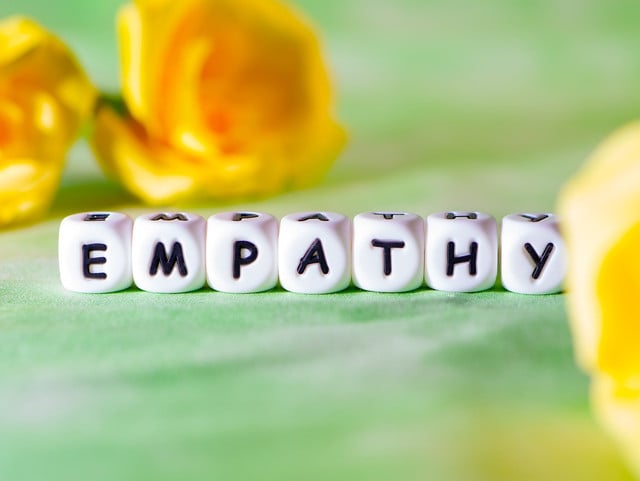Learning how to set boundaries in relationships is a foundation of any healthy relationship. So, let's talk about why they're so important and how you can successfully set them.
Boundaries in relationships are the psychological line you draw between yourself and others. This line can be emotional and psychological, and in romantic relationships, friendships, family relations or work relationships.
The purpose of boundaries isn’t to isolate yourself. Rather, it’s a healthy way of communicating your preferences and expectations. It’s also a necessary step for protecting your own well-being. By creating healthy boundaries you can improve your relationships. Often when people don’t express what behaviors make them uncomfortable, it can lead to resentment, dissatisfaction and breakdowns in communication.
So, let’s look at how to set boundaries in relationships.
1. How to Set Boundaries in Relationships: Empathy Vs. Compassion

(Foto: CC0 / Pixabay / DaphneArtsDesigns)
Mary Kate Lee, a researcher at Syracuse University, points out, setting boundaries is about understanding the difference between empathy and compassion.
- Compassion is about responding to the suffering of others and the desire to alleviate their pain.
- Empathy is when we place ourselves in the emotional and cognitive position of someone else.
While you can show compassion towards a person, you can still have an emotional distance from their situation. Whereas, empathy means taking on their emotions as your own. And this is where the danger lies.
Empathy is important for building relationships. However, we need to be cautious about empathizing with everyone all the time. This can be emotionally draining and can cause mental exhaustion.
In any relationship, we need to set our own lines about when to extend empathy as opposed to compassion. We can always choose to help our friends and partners when they need us. But we also need to learn self-love in order to be aware of our own psychological needs.
In short, making this distinction is the first step toward healthy boundaries.
2. Consider Your Needs When Setting Boundaries



(Foto: CC0 / Pixabay / rdmphotosltd)
Setting boundaries is about understanding what you want from a relationship. Sometimes boundaries are more for yourself than the other person. For instance, you may not be comfortable with public displays of affection or certain financial and social behavior.
The first thing to remember is: you should never feel shame about admitting what your needs are.
If you need guidance about what your boundaries are, consider your own values and beliefs. Use these as a guide when setting down what you want and don’t want from a relationship.
If going to bed at 9 pm every night is what makes you happy, tell that to the other person. Needs can take many different forms. If necessary, you can write down a list of different areas where you want to maintain boundaries. It could include:
- Lifestyle: Are there dietary, social or financial habits that make you uncomfortable? For instance: smoking, going to the gym or spending time in a casino etc, you might explain that you do or don’t want to participate in these actions.
- Sex life: Are there things in the bedroom that you don’t like? Your partner needs to respect these boundaries. Communicate them clearly.
- Homelife: Do you feel you are taking on more burdens than the other person? It may be important to discuss how chores and other work are divided around your home.
- Beliefs: Do you have religious or cultural beliefs that you want to maintain? It is a good idea to lay out what your practices entail, how often they will happen and when.
3. Good Communication



(Foto: CC0 / Pixabay / StockSnap)
The next thing to consider is how to communicate your boundaries to others.
Communication is vital for the sustainability of any relationship. The University of San Francisco concluded that communication is one of the most important factors in feeling satisfied in a marriage.
They highlight the following areas as being key to good communication:
- Engagement: Here, engaging means responding and acknowledging the other person.
- Respect: When approaching a discussion of boundaries, it’s important to avoid criticism, defensiveness and contempt.
- Managing expectations: This point is about avoiding making assumptions. You can’t assume the other person knows your boundaries if they aren’t communicated clearly. Also called “negative mind reading”, this is when we assume the other person knows our mind. You should always verbalize your expectations so there are no misunderstandings.
One of the most effective ways to communicate boundaries is openness. Openness involves respect for the other party’s feelings and beliefs. It engages with the other person as an equal and does not make assumptions. If you communicate this way, it’s easier for the other person to reciprocate. And don’t be afraid to reassert your boundaries when needed. When in doubt, try and stick to the 7 Cs of Communication to make sure you are getting across exactly what you mean when in exchange with another person.
Check out our 5 lessons on how to be more patient if you are struggling to actively listen to your partner(s) and give them time to communicate their needs to you.
4. Setting Consequences as Part of Your Boundaries



(Foto: CC0 / Pixabay / ottawagraphics)
While it’s important to be open to other opinions and beliefs, ultimately your boundaries should always come first. You should not accept something which makes you uncomfortable.
And, in drawing these lines, you need to let the other person know you are firm in this decision. If you have explained your boundaries and someone is unable to accept this, you have a choice to make.
What happens if someone violates your boundaries?
This might be physically, emotionally or sexually. You might prefer to remind the other person of your boundaires, if it was a genuine mistake — but sometimes, further action is needed. For your long-term wellbeing, it may be time to reevaluate that relationship. If it is taking more than it is giving, you should ask yourself whether it is worth continuing. When evaluating these aspects closely, you might see signs of a toxic relationship or identify manipulative behaviours like hoovering, or the use of flying monkeys. Check out our guides on how to best act in those situations.
In some cases you can clearly tell a person – if X happens again, I will not be able to continue this relationship. This means you have to follow through. It may be difficult, but remember this is for their benefit as much as yours. If you are unhappy with a relationship, it will mean that neither of you will gain anything from continuing.
5. Reflection: A Crucial Part of Setting Boundaries in a Relationship



(Foto: CC0 / Pixabay / Abbat1)
Self-reflection is another crucial aspect of maintaining boundaries.
Humans are changeable and ever-growing beings. What worked before may not always work in future. Establishing your boundaries doesn’t mean they are set in stone. The whole point of creating boundaries is about responding to your needs.
If your needs change, your boundaries might change too. Don’t feel limited or afraid to make changes. If you feel something needs to change, take some time to reflect on where the problem lies. Future self journaling, for example, can help you get a clearer picture of the person you want to be, and the relationships you want to have.
When communicating your (new) boundaries, make your reasons as well as your expectations clear. In essence, changing your boundaries is no different than making them.
6. Look Out for Warning Signs



(Foto: CC0 / Pixabay / geralt)
Sometimes when someone breaks a boundary you have set, it isn’t always obvious. Recognizing broken boundaries can sometimes be one of the hardest parts in how to set boundaries in relationships. You should be aware of your own behavior just as much as theirs.
- Do you often find yourself justifying the actions of someone else?
- Do they ever make you doubt your decisions?
- Do you feel shame during conversations with your partner for no apparent reason?
- Do you sometimes feel your choices are being disregarded?
If you regularly find yourself in such situations, it may be a subtle sign of boundaries breaking down. Perhaps, the other party is unconscious of this. Or, they may be fully aware of it.
Don’t feel bad if a boundary break has occurred. If you are unhappy, it just means it’s time to rebuild. When something happens that makes you uncomfortable, you can say ‘No’. It doesn’t have to be aggressive or done in irritation. But it must be firm. If you feel you aren’t able to communicate this message, it is better to take some time away from the person in question or seek counseling to mediate the problem.
Remember the point of a relationship is not perfection — it’s happiness.
Read on:
- The Harmful Effects of Negative Self-Talk & How to Stop It
- Long Distance Friendship: Maintaining Relationships from Afar
- The 9 Best Eco-Friendly Summer Activities For Adults
Important Information regarding Health-related Topics.
** Links to retailers marked with ** or underlined orange are partially partner links: If you buy here, you actively support Utopia.org, because we will receive a small part of the sales proceeds. More info.Do you like this post?







